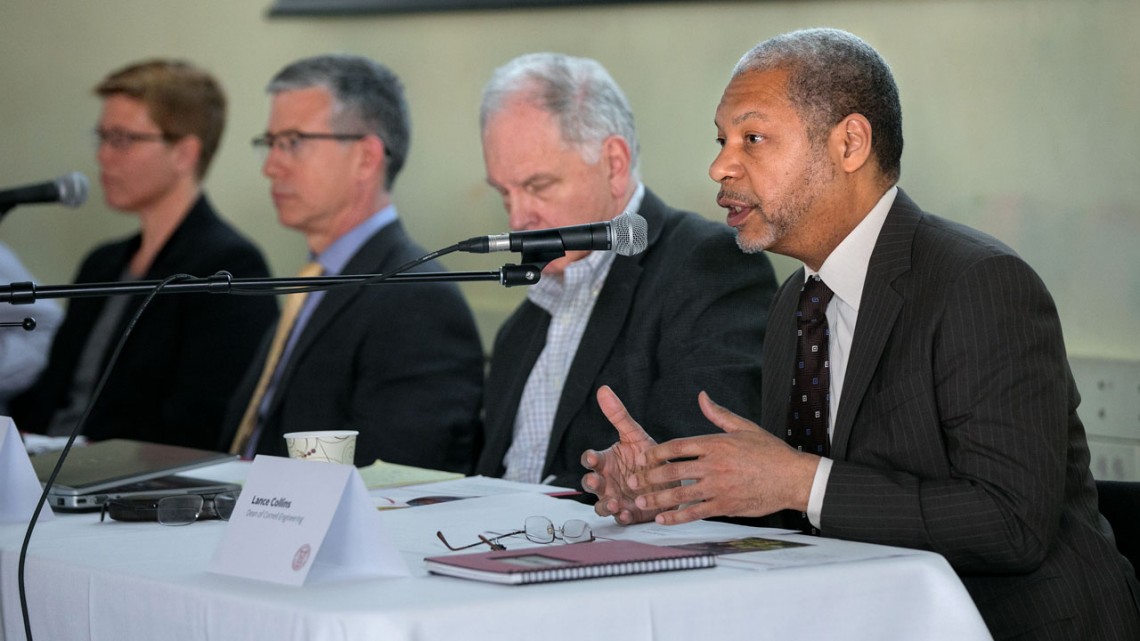
Dean Lance Collins, right, explains how Cornell strives to reduce its energy footprint. Also pictured are, from left, Katie Keranen, assistant professor of earth and atmospheric sciences; Rick Burgess, vice president for facilities and campus services; and Jefferson Tester, professor of engineering.
Cornell experts aim for carbon neutrality via Earth Source Heat
By Blaine Friedlander
Cornell engineering faculty and facility experts met with more than 100 members of the Ithaca community May 17 at an open forum to give an update on the Ithaca campus’s path toward carbon neutrality and its goal to heat campus in a climate-friendly way.
Lance Collins, the Joseph Silbert Dean of Engineering, led off the Earth Source Heat panel discussion by noting how the university strives to reduce its energy footprint. For two decades Lake Source Cooling has reduced air conditioning energy demand, and the university has installed enough solar panels to provide about 7 percent of its electric needs.
Referring to the university’s hydroelectric plant built in the 1880s in Fall Creek Gorge, Collins said: “Cornell was really renewable before that was even a term. So back in the 1880s, we could claim carbon neutrality. We’re going to try to return to that lofty goal.”
Panelist Todd Cowen, professor of civil and environmental engineering, and the Kathy Dwyer Marble and Curt Marble Faculty Director for Energy at the Atkinson Center for a Sustainable Future, explained the university’s energy use is on a downward, stable trend over the past decade.
Cowen said Cornell’s need to purchase electricity has virtually disappeared. An important remaining problem: heating campus while reducing the carbon footprint. The university had considered biomass combustion and ground-source heat pumps as possible options, but the associated costs and environmental impacts of those heating concepts led the group to Earth Source Heat, he explained.
During Ithaca’s frigid winters, engineers believe earth-source heating can eliminate the need for natural gas-based (carbon) warmth. A well can be drilled to a depth of 3 miles, where the temperature is 80-100 degrees Celsius. Cold water would be piped into the well where it would be heated. In an exchanger, the hot water would warm cold water that would be circulated to campus buildings, according to Jefferson Tester, the Croll Professor of Sustainable Energy Systems and the chief scientist for the Earth Source Heat project.
“Even in the Eastern region – the Appalachian Basin – there are above-average temperatures at [these depths],” said Tester, who explained how the project could be economically transformative.
Tester said Cornell has a tradition of innovative energy projects, with an “enlightened and aggressive” facilities group. “They are extremely good at reducing the energy footprint here on campus. … We have a lot of faculty that have expertise that could be useful. [This project] is scalable for other communities. This is a living lab,” he said. “Cornell is committed to carbon neutrality.”
Rick Burgess, vice president for facilities and campus services, outlined phases of how the university plans to move forward on Earth Source Heat. The university is in the preparatory phase, planning, conducting research and engaging with the community. Burgess hopes Cornell will drill a single test well, then build a demonstration well for a limited part of campus. If research results are good, he hopes to deploy the well project to heat campus fully.
In the research phase, Katie Keranen, assistant professor of earth and atmospheric sciences, explained that Cornell will conduct geological characterization of the rock formations under campus and establish baseline seismicity.
While earth-source heating and fracking for natural gas may seem similar, Anthony Ingraffea, the Dwight C. Baum Professor in Engineering, pointed out some important differences. In shale fracking, carbon-rich natural gas is extracted from rocks. For Earth Source Heat, there is no carbon fuel withdrawal. In addition, the Earth Source Heat project will not inject millions of gallons of fracking fluid into wells.
“The main difference between shale and what we’re doing is we’re mining heat, not fossil fuels,” said Ingraffea, a fracking shale gas opponent. “We’re not adding to greenhouse gases; we’re subtracting greenhouse gases from Cornell.”
Media Contact
Get Cornell news delivered right to your inbox.
Subscribe


